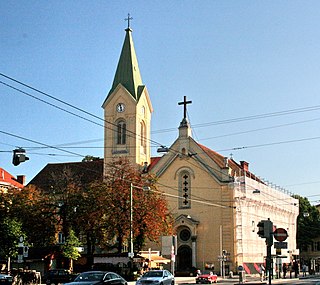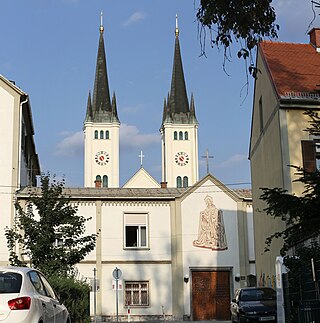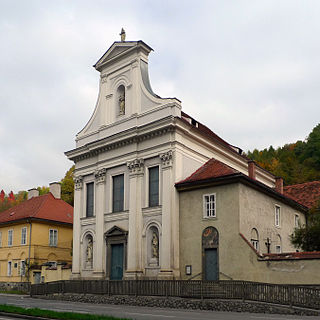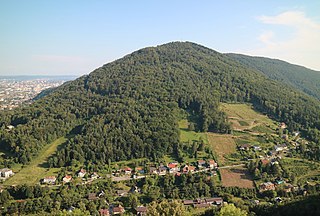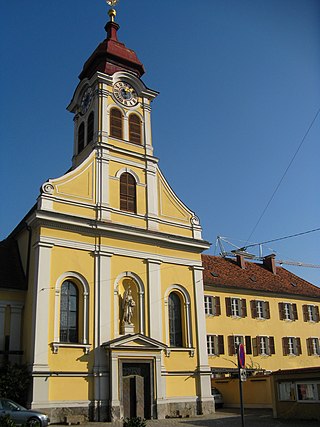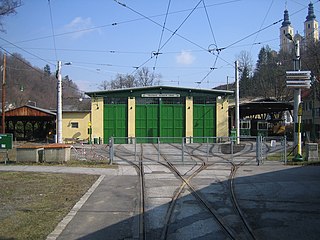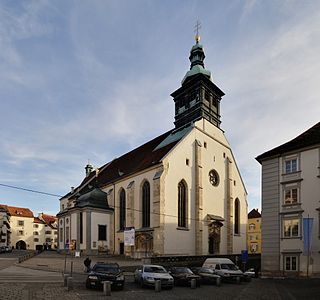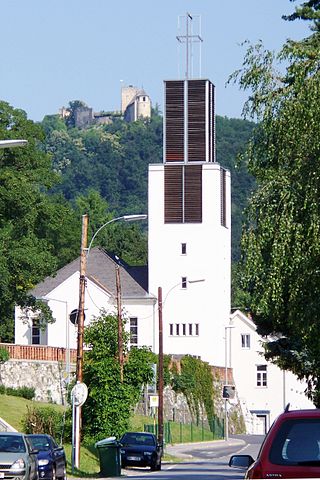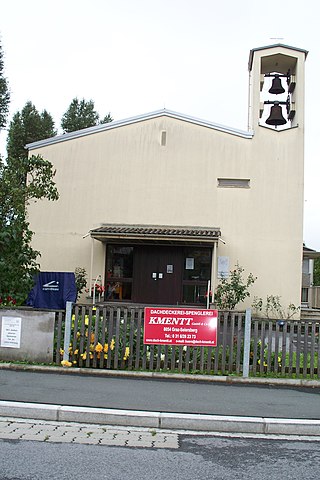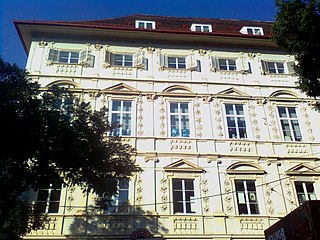84 Sights in Graz, Austria (with Map and Images)
Legend
Welcome to your journey through the most beautiful sights in Graz, Austria! Whether you want to discover the city's historical treasures or experience its modern highlights, you'll find everything your heart desires here. Be inspired by our selection and plan your unforgettable adventure in Graz. Dive into the diversity of this fascinating city and discover everything it has to offer.
Sightseeing Tours in GrazActivities in Graz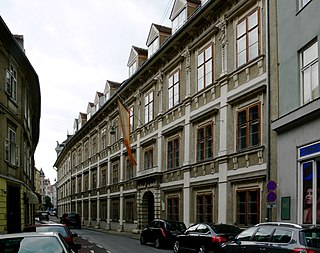
The Universalmuseum Joanneum is a multidisciplinary museum with buildings in several locations in the state of Styria, Austria. It has galleries and collections in many subject areas including archaeology, geology, paleontology, mineralogy, botany, zoology, history, art and folk culture. It is the oldest museum in Austria as well as the largest universal museum in central Europe with over 4.5 million objects in 13 departments and 12 locations in the Styrian cities of Graz, Stainz, Trautenfels, and Wagna. To reflect this status and its growth over the last two centuries, as well as to present a more recognizable image internationally, the Landesmuseum Joanneum was officially renamed to Universalmuseum Joanneum on 10 September 2009.
The Styrian Armoury, in the Austrian city of Graz, is the world's largest historic armoury and attracts visitors from all over the world. It holds approximately 32,000 pieces of weaponry, tools, suits of armour for battle and ones for parades.
The Murinsel in Graz, Austria, is an artificial floating "island" in the middle of the river Mur and links the two banks on both sides. At night the blue navigation lights that surround the structure light up. This landmark of Graz was designed by New York City artist Vito Acconci on the occasion of Graz becoming the 2003 European Capital of Culture.
The Graz Museum, formerly City Museum Graz, in Sackstraße 18 is the cultural -historical museum of the Austrian city of Graz. The collections and exhibitions deal with city history and convey them. The historical collection and permanent exhibition “360Graz | A history of the city ”shows the political, economic and social history of the city of Graz. The museum is located in the baroque Palais Khuenburg, in which the Austrian heir to the throne Franz Ferdinand was born in 1863. Another location is located on the stable bastion near the summit plateau of the Graz Schloßberg.
The Schlossberg is a tree-clad hill and the site of a fortress in the centre of the city of Graz, Austria. The hill, at 473 metres (1,552 ft) above sea level, is now a public park and affords extensive views of the city. It is the site of several entertainment venues, cafés, and restaurants, and is managed by Holding Graz, the city-owned utility company.
6. Katharinenkirche und Mausoleum
The mausoleum of the Holy Roman Emperor Ferdinand II (1578–1637) next to Graz Cathedral is a monumental sacred and representative building from the 17th century, which was joined together from two existing buildings. The complex, which began in 1614, was continued until 1640, interrupted several times and completed in 1714 after long interruptions in construction, consists of St. Catherine's Church and the adjoining burial chapel of Emperor Ferdinand II and his family. They form one of the most important architectural monuments in Austria from Mannerism, the transitional period from the Renaissance to the Baroque.
7. Friendly Alien

The Kunsthaus Graz, Grazer Kunsthaus, or Graz Art Museum was built as part of the European Capital of Culture celebrations in 2003 and has since become an architectural landmark in Graz, Austria. Its exhibition program specializes in contemporary art from the 1960s onwards.
8. Mariahilfer Kirche

The Church of Mariahilf (Mariahilfkirche) in the Styrian capital of Graz is a pilgrimage church and since 1783 the parish church of the parish of Graz-Mariahilf in the deanery of Graz-Mitte. Attached to the church is the Minorite monastery in Graz.
9. Schlosskirche Sankt Martin

St. Martin's Castle is located in the XVI district of Graz Straßgang in an elevated position next to the castle church of St. Martin on the southeastern foothills of the Buchkogel. The castle is a listed building (list entry).
10. Barmherzigenkirche Maria Verkündigung
The Church of Mercy of the Annunciation of the Virgin Mary is a Roman Catholic church in the fourth district of Lend, Graz. The sacred building is located on Annenstraße between Südtiroler Platz and Roseggerhaus. The church is a pastoral care center of the Convent of the Brothers of Mercy, who also look after the hospital, and belongs to the parish of Graz-Mariä Mariahilf in the deanery of Graz-Mitte of the city church of Graz.
11. Kindermuseum FRida & freD
Frida & Fred is a children's museum in Graz's Augarten. It was built in 2003 under the direction of the architects Hemma Fasch and Jakob Fuchs. Basically, the museum with its experiential exhibitions is aimed at the age group of 3 to 12-year-olds. The exhibitions are designed under the motto "Hands On – Minds On" in such a way that the children can help shape and try things out themselves.
12. Filialkirche Mariagrün
The Roman Catholic Mariagrün Church, also known as the Pilgrimage Church of the Visitation of the Virgin Mary or Station Chaplaincy Graz-Mariagrün, is the centre of Mariagrün, a small district of Graz, in the district of Mariatrost. It is considered the most important church foundation of a citizen of the city of Graz.
13. Heilandskirche
The Church of the Redeemer is one of the five Protestant churches in the Styrian capital of Graz. It is the parish church of the Protestant parish of A.u.H.B. Graz-Heilandskirche. The church was built in the early historicist style. It is located on Kaiser-Josef-Platz in the 2nd district of St. Leonhard in Graz.
14. Graz Hauptbahnhof
Graz Hauptbahnhof, abbreviated Graz Hbf, is the main railway station in Graz, the capital of the Austrian federal state Styria. The station is located some 2 kilometres (1.2 mi) west of the city centre, to which it is connected by tram. It is the most frequented railway station in Austria, outside of Vienna.
15. Stadtpfarrkirche zum Heiligen Blut
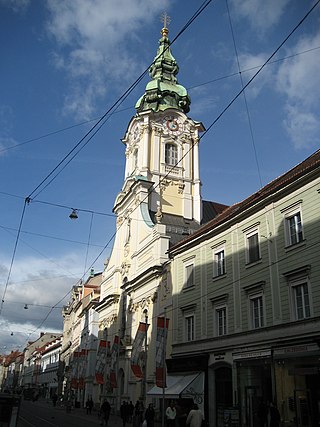
The Roman Catholic Church of the Holy Blood, or Provost's, Main and Parish Church of Graz-Hl. Blut, or Grazer Stadtpfarrkirche for short, is located in the Graz district of Innere Stadt. It is the parish church of the parish of Graz-Hl. Blood in the deanery of Graz-Mitte of the city church of Graz.
16. Schloßbergbahn
The Schlossbergbahn, or Schloßbergbahn, is a funicular railway in the Austrian city of Graz. It connects the city centre with the Schloßberg, a hill and the site of a demolished fortress, with extensive views over the city.
17. Anna Plochl
Anna Maria Josephine Plochl was the morganatic wife of Archduke John of Austria. She was given the title Baroness von Brandhofen and then Countess von Meran. She and her husband were the parents of Franz, Count von Meran.
18. Sankt-Josef-Kirche
The Church of St. Joseph, also known as the Church of St. Joseph or the Parish Church of Graz-St. Josef or Jubiläumskirche is a Catholic parish church in Graz, Germany. It is the seat of the parish of Graz-St. Josef in the deanery of Graz-Süd of the Stadtkirche Graz, and to St. Joseph, the foster father of Christ. The building is located at the intersection of Schönaugürtel and Schönaugasse in the sixth district of Graz, Jakomini. The church is a listed building (list entry).
19. Leechkirche

The Leechkirche, actually Maria Himmelfahrt am Leech, is the oldest Roman Catholic church in Graz. It is somewhat hidden on a hill in the Geidorf district and is accessible from both Zinzendorfgasse and Glacisstraße. It forms the curate beneficiary Graz-Leechkirche of the Graz Cathedral Parish in the Graz-Mitte deanery of the City Church of Graz.
20. Karmelitenkirche Maria Schnee
The Maria Schnee Monastery is a convent of the Discalced Carmelites in Graz's Grabenstraße in the third district of Geidorf. The monastery is located at the foot of the Reinerkogel, a little off the Grabenstraße. In the inner courtyard of the monastery is the monastery and pilgrimage church of Maria Schnee.
21. Kirche der Barmherzigen Schwestern
The Convent of the Sisters of Mercy of St. Vincent de Paul in the fourth district of Lend in Graz is a branch of the Sisters of Mercy of St. Vincent de Paul FdC (BHS/TdchL). The Church of the Immaculate Conception is the monastery church.
22. Lazaristenkirche zur Schmerzhaften Mutter
The Lazaristenkirche zur Schmerzen Mutter or St. Mary's Church or Church of the Sorrowful Mother is a Roman Catholic church in the fourth district of Lend, Graz. It is the parish church of the parish of Graz-Schmerze Mutter (Marienpfarre) in the deanery of Graz-Nord of the city church of Graz, and the monastery church of the mission house of the Lazarists Graz, provincial office and study house (clergy) of the order. Directly next to the church is the convent of the Sisters of Mercy Graz.
23. Fairytale Express
The Fairytale Express Graz is a 2 km (1.2 mi) long 600 mm gauge grotto railway in the tunnel of the Schloßberg in Graz. It starts in the tunnel at the lower level of the Schloßberg lift, which is accessible from Schloßbergplatz.
24. Kirche Hl. Kyrill und Method
The Church of St. Cyril and Methodius is a Serbian Orthodox church in the 5th district of Gries, Graz. The originally Roman Catholic Church of the Crucified Saviour is now dedicated to the Slavic apostles Cyril and Methodius.
25. Orpheum
The Graz Orpheum in the Lend district is one of the oldest venues in Graz; it is housed in the building that replaced the Grazer Varieté, which existed from 1899 to 1936, in 1950 and is part of the Grazer Spielstätten GmbH, founded in 2008, along with the Schloßbergbühne Kasematten and the Dom im Berg.
26. Karmelitinnenkirche zum Heiligen Josef
The Carmelite Church of St. Joseph is a Roman Catholic church building in the third district of Geidorf in Graz, which is the monastery church of a convent of the Discalced Carmelites. Before that, there was already a church dedicated to St. Joseph in Graz, which was signed in the 1930s.
27. Buchkogel
The Buchkogel, at 656 meters above sea level, is a hill in the Austrian state of Styria. It is located in the southern part of the Grazer Bergland in the west of the state capital Graz. The mixed forests within the Plabutsch ridge serve as a popular recreation area. Parts of the karstified hill were settled back in the Chalcolithic period and served for limonite mining during the Middle Ages and World War II. On the top there is the historical Kronprinz Rufolf observation tower built in 1879. The name Buchkogel is either derived from a lost castle or the extensive beech population.
28. Israelitischer Friedhof
The Jewish Cemetery Graz is a Jewish cemetery founded in 1864/65 in today's Wetzelsdorf district of Graz. Since that time, it has served as the main burial place of the Jewish community in Graz. In 1910, the ceremonial hall of the Graz architect Alexander Zerkowitz was inaugurated on the cemetery grounds. During the November pogroms of 1938, the morgue was set on fire and destroyed on November 10, 1938. The site was expropriated and sold to the city of Graz. With the exception of the destroyed ceremonial hall and a few graves, however, the cemetery remained intact until the end of the war and was restituted to the Jewish Community in 1946. On 11 November 1991, a new ceremonial hall was opened following the "commemorative year 1938/88". The cemetery is a listed building.
29. Fürstenstand
The Fürstenstand is the 754 m high main summit of the Plabutsch, the local mountain of Graz in Styria. Directly on the summit is the Fürstenstandwarte, a historic stone observation tower that was given a structure with a steel and wood roof in 2023/2024.
30. Pfarrkirche Sankt Andrä
The parish church of St. Andrä is located on St.-Andrä-Platz in the 5th district of Graz Gries. It is dedicated to the Apostle Andrew, and is the parish church of the parish of Graz-St. Andrä in the deanery of Graz-Mitte of the city church of Graz.
31. Puchmuseum
The Johann Puch Museum Graz is a museum in the city of Graz in Styria and is located on the site of Johann Puch's first work. It is not a factory museum, but was created on a private initiative. Since 2012, it has been housed in the last authentic hall of the Puchwerke, Hall P, which is a listed building as the Johann Puch factory hall.
32. Pfarrkirche St. Veit
The parish church of Graz-St. St. Vitus is a Roman Catholic church in St. Veit, a district of the twelfth district of Andritz, Graz, Germany. It is dedicated to St. Vitus, and is the parish church of the parish of Graz-St. Veit in the pastoral care area Graz-Nord of the Graz region.
33. Stiegenkirche
The Stiegenkirche is a Roman Catholic church in the first district of Graz, Innere Stadt. It can be entered through a characteristic staircase from Sporgasse, as it stands behind the row of houses. It forms the "Rectorate at the Staircase Church in Graz" of the Graz Cathedral Parish in the Graz-Mitte deanery of the City Church of Graz.
34. Bürgerspitalskirche zum Heiligen Geist
The Bürgerspitalkirche zum Heiligen Geist in Graz is a Roman Catholic church in the 5th district of Gries, Graz. Today it is the beneficiary at the Church of the Holy Spirit in the Bürgerspital, which belongs to the parish of Graz-St. Andrä, and belongs to the deanery of Graz-Mitte of the city church of Graz.
35. Kirche zum heiligen Kreuz
The church and the convent of the Sisters of the Cross are located in Kreuzgasse in the third district of Geidorf in Graz. The convent is a branch of the Sisters of Mercy of the Holy Cross. Next to it is the Sanatorium of the Sisters of the Cross, a general hospital. Both buildings, the monastery and the main wing of the hospital complex, are listed buildings.
Wikipedia: Kirche und Konvent der Kreuzschwestern (Graz) (DE)
36. Kasematten
The Schloßbergbühne Kasematten, also known as the Kasemattenbühne, is an open-air stage on the Schloßberg in Graz. Located in the Innere Stadt district of Graz, it is part of the UNESCO World Heritage Site Stadt Graz – Historisches Zentrum and Schloss Eggenberg. The name is derived from the cellar vault of the former castle captain's house of the castle on the Schloßberg in Graz, known as the casemate, which forms the structural framework.
37. Platte
The Platte is a 651 m high elevation in the city of Graz. The summit is formed by a plateau of about 1 ha, in the middle of which stands the Stephanienwarte, a former weather station. Today, there is a modern environmental and air quality monitoring system on the tower. The elevation is developed for tourism and offers a panorama of Graz from the Stephanienwarte.
38. ehem. Barackenkirche
The Barrackenkirche Graz-Liebenau is a former emergency church in the Graz district of Liebenau, St.-Paulus-Platz 1. It is now used as a cultural and meeting centre. The building is one of the last two surviving barrack churches in Austria and is a listed building; the other is in operation in Nöstlbach near St. Marien, Upper Austria.
39. Franziskanerkirche
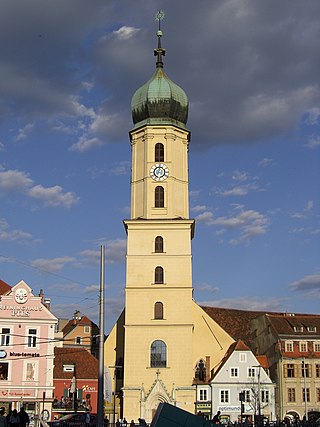
The Franciscan Church and Franciscan Monastery are a church and associated monastery in the centre of the city of Graz, Austria. The monastery was founded by the Franciscan order, who still own it, and is first mentioned in 1239.
40. Eisbründlhöhle
The Eisbründlhöhle or Bründlhöhle is a karst cave in the district of Straßgang in the Styrian capital Graz. The episodic Bründlbach rises from the cave. The Bründlteiche ponds that still follow the slope and the surrounding forest not far from St. Martin Castle form a popular local recreation area.
41. Catholic Church
The Church of the Most Holy Redeemer is the institutional church of the LKH University Hospital in Graz-St. Leonhard and parish church of the parish of Graz-Holy Redeemer in the provincial hospital in the deanery of Graz-East of the city church of Graz.
42. Grabenkirche
The Grabenkirche, also known as the parish church of Graz-Graben, is a Roman Catholic parish church in the third district of Geidorf in Graz, Styria. The church, which is under the patronage of St. John the Baptist, was once a settlement of the Capuchins together with the Graben monastery and now belongs to the Graz-Nord pastoral care area of the Graz City Church in the Diocese of Graz-Seckau. The church is a listed building (list entry).
43. Rupertikirche
The branch church of St. Rupert, also known as St. Rupert's Church, named after St. Rupert of Salzburg, is located in Hohenrain, municipality of Hart bei Graz, directly on the city limits of Graz near Lustbühel Castle. As a branch church, it belongs to the parish of Graz-St. Peter in the deanery of Graz-South of the City Church of Graz.
44. Doppelwendeltreppe
The Graz double spiral staircase, a twin spiral staircase, was built by stonemasons in 1499/1500 during the reign of the German King and later Emperor Maximilian I by an unknown master builder of a medieval builder's workshop in Graz Castle.
45. Kirche Maria im Elend zu Straßgang
The Church of Mary in Elend in Straßgang is a Roman Catholic parish and pilgrimage church in the 16th district of Graz, Graz. In a church of the misery of Mary, the flight to Egypt from the infanticide Herod is commemorated; this incident is one of the second of Mary's seven sorrows. The feast of patronage is therefore celebrated on the feast of the Seven Sorrows of Mary, 15 September.
46. Volkskundemuseum
The Folklore Museum in the former Capuchin monastery at St. Paul's Gate in Graz takes the present with its pressing socially relevant topics and cultural phenomena as the starting point for its exhibitions, educational programmes and events.
47. Landplagenbild
The landscape plague picture, also called "God Plague Picture", is located on the southern outer wall of Graz Cathedral. The fresco, created in 1485, is probably by Thomas von Villach. It is considered one of the historically and artistically most important frescoes in Styria.
48. Tramway Museum Graz
The Tramway Museum Graz is a transport museum in the Austrian city of Graz, specialising in the history of the Graz tramway network. It is located in the former tram depot at the Mariatrost terminus of Graz tram route 1.
49. Altkatholische Christophoruskirche
The Old Catholic Church of the Resurrection is the parish church of the Old Catholic parish of Graz for Styria and southern Burgenland. It was dedicated to St. Christopher and was renamed the Old Catholic Church of the Resurrection in 2010 after a renovation. It is located in the 5th district of Gries, in the building of today's New Middle School St. Andrä.
50. Grazer Dom
Graz Cathedral, also called St. Giles' Cathedral, is the cathedral church in the Austrian city of Graz, dedicated to Saint Giles. It is the seat of the bishop of the Steiermark diocese from 1786, called the Diocese of Graz-Seckau.
51. Next Liberty
The Next Liberty is a children's and youth theatre in the first district of Graz, Innere Stadt. With over 65,000 spectators and more than 200 performances per season, it is one of the five most successful in the German-speaking world. The company belongs to the Theaterholding Graz.
52. Sommerrefektorium der Jesuiten
The former Jesuit summer refectory is a listed building on the so-called Rosenhain in the 3rd district of Geidorf in Graz. The Jesuits owned large parts of this hill northeast of the city center, which they used with the construction of the refectory in 1654, among other things, for the recreation of the members of the order. After several changes of ownership and a fire in 1984, the building existed as a ruin for almost 40 years, and reconstruction by the University of Graz began in 2022.
53. Sankt-Antonius-Kirche

St. Anthony's Church is a Roman Catholic church in the first district of Graz, Innere Stadt. It is located on the eastern slope of the Schlossberg next to the Styrian Folklore Museum in Paulustorgasse. It is subordinate to the parish of Graz-Dom, which belongs to the deanery of Graz-Mitte of the city church of Graz.
54. Museum der Wahrnehmung
The Museum of Perception is a museum in Graz, Germany, which opened in 1996. It deals with works from all areas of art, music, architecture, philosophy and literature that deals with phenomena of perception. It is housed on the upper floors of the octagonal, listed building, which stands freely on the edge of the Augarten and originally served exclusively as a municipal public bath.
55. Sankt Christoph
The Church of St. Christoph or Parish Church of Graz-Thondorf is a Roman Catholic church in the 7th district of Liebenau in Graz. It is the parish church of the parish of Graz-St. Christoph in Thondorf in the deanery of Graz-Süd of the city church of Graz.
56. Salvatorkirche
The Salvatorkirche is a Roman Catholic church in the third district of Geidorf, Graz. It was an expository of the Graben parish and was elevated to an independent parish in 1981, and is the parish church of the parish of Graz-Christus der Salvator in the deanery of Graz-Ost of the city church of Graz. The Salvatorkolleg Graz, the Graz branch of the Salvatorian SDS, is also located there.
57. Jungfernsprung
The Jungfernsprung is a rock spur in the western Graz Uplands in the Austrian state of Styria. The dolomite rock, which owes its name to a legend, is located 130 metres northeast of the Gösting castle ruins in the provincial capital of Graz. As a popular vantage point above the Mur Valley, the Jungfernsprung is one of the most important natural sights in the greater Graz area and was a sought-after postcard motif for decades.
58. Sankt Anna
The St. Anne's Church or Parish Church Graz-Gösting is a Roman Catholic parish church in the 13th district of Gösting in Graz. It is the parish church of the parish of Graz-Gösting in the deanery of Graz-West of the city church of Graz.
59. Sankt Johann und Paul
The Church of St. John and Paul is a small Roman Catholic mountain church in the 15th district of Graz, Wetzelsdorf. It is owned by the city of Graz and is subordinate to the City Church of Graz as a chapel of the parish of Graz-Christkönig in the deanery of Graz-West.
60. Gösting castle
Gösting Castle is a Baroque castle in Graz, Styria. It is located at the foot of the castle hill on the Thaler Bach in the 13th district of Gösting in Graz. The building can be reached via bus lines 40 and 65, which terminates in front of the castle.
61. Welsche Kirche
The Welsche Kirche is a Roman Catholic church in the 5th district of Gries, Graz. Today it is the local chaplaincy of Graz-Welsche Kirche St. Franz de Paula, which belongs to the parish of Graz-St. Andrä and belongs to the Graz-Mitte deanery of the Graz City Church.
62. Kirche zur Schmerzhaften Mutter
The Church of the Mater Dolorosa or Church of the Sorrowful Mother is a small church on the city limits of Graz in Messendorf in the eighth district of St. Peter. It forms the station chaplaincy Graz-Messendorf of the parish of Graz-St. Peter in the deanery of Graz-South of the city church of Graz and is connected to the Messendorf mission house of the Comboni Missionaries.
63. Erlöserkirche
The Church of the Redeemer is an Evangelical Lutheran church building in the seventh district of Liebenau in Graz. It belongs to the Protestant daughter congregation of Graz-Liebenau in the Superintendence of Styria of the Evangelical Church A. B. in Austria.
64. Schloss Messendorf
Schloss Messendorf is located on St.-Peter-Hauptstraße in the district of Messendorf in the eighth district of St. Peter in Graz. The building, formerly used as a special state hospital for psychiatry and neurology, currently houses the Graz Waldorf School.
65. Schulschwesternkirche zur Unbefleckten Empfängnis
The School Sisters' Church of the Immaculate Conception is a Roman Catholic church in the 14th district of Graz Eggenberg and with the associated private school. She belongs to the Graz School Sisters and is part of the parish of Graz-St. Vinzenz and thus belongs to the deanery of Graz-West of the city church of Graz.
66. Synagoge
The New Synagogue of Graz is a Jewish congregation and synagogue, located on David-Herzog-Place, on the right bank of the Mur River in the Gries neighborhood, in the city of Graz, Austria. The synagogue serves the Jews of Graz, Styria, Carinthia, and southern parts of Burgenland.
67. Palais Welsersheimb
Palais Welsersheimb is a baroque city palace in Graz, Germany, on the corner of Hans-Sachs-Gasse and Am Eisernen Tor in the Innere Stadt district. Today, the premises are home to the Moser bookstore, among others.
68. Mühlschlössl
The Mühl-Schlössl is a small castle on the edge of the Volksgarten in Graz, in the fourth district of Lend, Graz. It is probably named after its location to the left of the Mühlgang, at most 50 m away from the Marienmühle. It was acquired as a vicarage by the Protestant community in 1908 and adapted as a vicarage in 1910. From 1912 onwards, the Protestant Kreuzkirche was built to the southwest and consecrated in 1914.
69. Rosenschlößl

The Rosenschlößl is a small castle with a servants' house on the Rosenberg in the eleventh district of Mariatrost in Graz. Since 1948, the "Rosenschlößlweg" has also been named after this building.
70. Pfarrkirche Don Bosco
The Church of Don Bosco is a Catholic parish church in the fifth district of Gries, Graz. It belongs to the deanery of Graz-West of the city church of Graz, and to the branch and parish center of the Salesians of Don Bosco SDB.
71. Burgtor
The Burgtor is located at the interface between Hofgasse and Erzherzog-Johann-Allee. It is located in the Inner City district of Graz and is part of the Graz City Crown. Apart from the outer Paulustor, the building is the only surviving Walltor in the city of Graz.
72. Frauenkogel
The Frauenkogel is a 561 m high hill in the western part of the Graz Uplands in the Austrian state of Styria. The elevation is located in the northwest of the provincial capital Graz. On the western slope are the listed remains of an early medieval refuge castle (list entry).
73. Hauenstein
The Hauenstein is a 650 m high hill in the Graz Uplands in the Austrian state of Styria. It is located in the northeast of the provincial capital Graz and is characterized by an extremely high biodiversity. In particular, the abandoned Kollermichl quarry developed into a secondary biotope for heat-loving plant and insect species.
74. Pfarrkirche Zur Heiligen Familie
The Church of the Holy Family, also known as the Parish Church of Andritz, is a Roman Catholic parish church in the twelfth district of Andritz, Graz. It is the parish church of the parish of Graz-Andritz in the deanery of Graz-Nord of the city church of Graz.
75. Christkönigskirche
The Christ the King Church in Raach is a small Roman Catholic church in the 13th district of Gösting in Graz. It belongs as a branch church to the parish of Graz-Gösting in the deanery of Graz-Nord of the city church of Graz.
76. Florianiberg
The Florianiberg is a 527 m high hill in the Austrian state of Styria. The elevation is located in the southwest of the state capital Graz and is known as the location of the Floriani Church from 1597. On the mountain, which was probably already settled in the Chalcolithic Age, there was also an early medieval refuge castle.
77. Freiheitsdenkmal
The (Eagle) Liberation Monument or Freedom Monument is a sculpture in the center of the Styrian capital Graz. The monument, created in 1960 by Wolfgang Skala, is dedicated to the end of the occupation in Austria and not, as previously assumed, to the liberation from National Socialism. This circumstance has recently been critically discussed.
78. Lustbühel
The Lustbühel is a 489 m high hill in the Austrian state of Styria. The elevation is located in the east of the state capital Graz and is known for the location of the castle of the same name, the Graz-Lustbühel Observatory and as a popular local recreation area. Since 1989, there has also been a small nature reserve.
79. Sankt Lukas
The Church of St. Lukas is a Roman Catholic church in the 5th district of Gries, Graz. The pastoral care centre is a branch church of the parish of St. Andrä and belongs to the Graz-Mitte deanery of the Graz City Church.
80. Ansitz Rothenburg
The Rothenburg Residence is a small castle in Graz. The history of the estate dates back to the 14th century, although the actual castle was probably not built until 1579. Since then, however, it has been rebuilt frequently.
81. Reinerkogel
The Reinerkogel is a 500 m high hill in the Graz Uplands in the Austrian state of Styria. It is located in the state capital Graz north of the centre on the left bank of the Mur and, with the Reinerkogelwarte, which was demolished in 1957, was a popular local recreation area, especially in the past.
82. Anstaltskirche LSF Graz
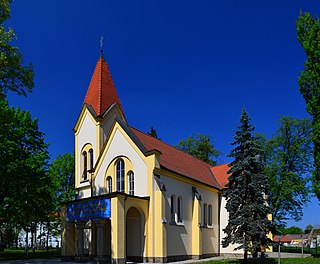
The Anstaltskirche Hl. Kreuz in the LKH Graz II Standort Süd is a church in the Graz district of Straßgang. It is located on the grounds of the southern location of the Graz II State Hospital and belongs to the parish of Graz-St. Elisabeth in Webling.
83. Halle für Kunst Steiermark
The Halle für Kunst Steiermark is an exhibition house for contemporary visual art in Graz. Since January 2013, the Kunstverein Medienturm has been responsible for the programmatic orientation and operation of the house.
84. Unbefleckte Empfängnis
The Church of the Immaculate Conception, Church of Mary Immaculate or Parish Church of Graz-Immaculate Conception is a Roman Catholic church in the 5th district of Gries, Graz. It is dedicated to the Immaculate Conception and parish church of the parish of Graz-Immaculate Conception in the hospital of the city in the deanery of Graz-Mitte of the city church of Graz.
Share
Disclaimer Please be aware of your surroundings and do not enter private property. We are not liable for any damages that occur during the tours.








